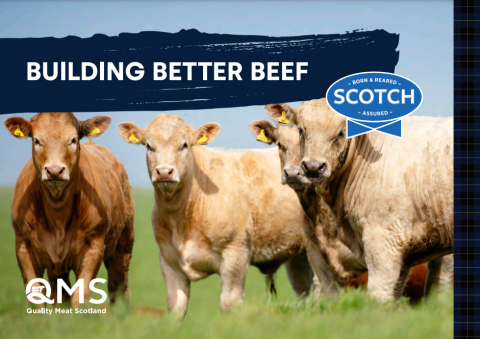Scroll down to download the report.
With one in five of Scotland’s farming’s workforce directly employed by suckler beef sector, Quality Meat Scotland’s (QMS) new report is set to unlock greater productivity, profitability and sustainability for a wealth of individuals and businesses.
QMS, HCC and AHDB commissioned ADAS to conduct the comprehensive study titled, ‘Building Better Beef’. It looks at on-farm management practices and provides an accessible, yet detailed understanding, of how to improve the profitability, productivity and sustainability of suckler beef herds.
The resulting report will be launched at AgriScot on 22 November 2023 and will also be available on the QMS website.
“This is the first time all the information in the industry has been pulled together, making it a one-stop shop for the factors which can make your suckler enterprise more resilient,” explained Bruce McConachie, Head of Industry Development at QMS.
“While you may be familiar with some of the elements within the report, we encourage you to reflect on what works and what’s challenging your suckler enterprise, and use this report as a prompt to review your business structure and processes. It could help you drive productivity and profitability.
Kim Matthews, AHDB Head of Animal Breeding and Product Quality added: “AHDB was delighted to partner with the other red meat levy bodies across the UK to commission this report. It brings together in one place the evidence to support farmers’ drive to improve the profitability and sustainability of their suckler enterprises. Many of our professional suckler producers will already be following the best practice recommendations made, but it is always worth reviewing what we are doing and seeing if there are any areas of opportunity to further improve. Importantly the work has also highlighted areas where there is more research needed to fill gaps in the evidence on what is best practice. We will use these in future months to inform our discussions with researchers and other research funders around the needs of the sector.”
John Richards, HCC Producer and Processor Lead said: “We were pleased to work with AHDB and QMS on this important area of work on understanding best practice for beef producers. Maintaining beef suckler herds is a crucial element to the UK and Wales’ agri-food supply and this report will inform and empower farmers to understand and implement research-led initiatives to maximise productivity and profitability.”
The report acknowledges the diversity of enterprises by explicitly outlining the reasoning, benefits and limitations of the approaches for the environment, infrastructure and set-up of different businesses – whether that’s an extensive upland hill farm, a more intensive lowland enterprise or something in between,
As well as delving into emerging ideas and technologies, researchers have used the breadth and depth of scientific evidence to identify eight priority areas for improving performance. They are presented as the ‘foundations of efficient suckler management’ and include reviewing your cow base, tightening calving blocks and adopting artificial insemination to improve performance.
Bruce said: “One study quoted in the report saw a 16% increase in calve income when cows have ideal, rather than low, body condition scores (BCS). It’s a good example of a fundamental management practice that can be overlooked when the pressure is on but has a significant financial impact.”
ADAS outlines other areas where scientific literature shows there are additional gains to be had. “While there is less research for these practices, there’s still important evidence showing they can have a significant effect on the bottom line,” explained Bruce. “They are for those who’ve got solid foundations and are looking to further enhance performance. The areas include tightening the block calving window, cull timings, breeding for improve calving ease and genomic techniques.”
Finally, the report looks at newer and less well researched approaches for refining high performing herds. “There are many exciting developments in suckler beef production – from rotational grazing with the use of geo-fencing to the use of sexed semen and artificial intelligence – and it’s important that these are also brought to the fore and put into context.”
“‘Building Better Beef’’ is another tool to allow you to reflect on where your suckler enterprise is today and where it could be in the future with the potential adoption of new technologies and ideas.”




